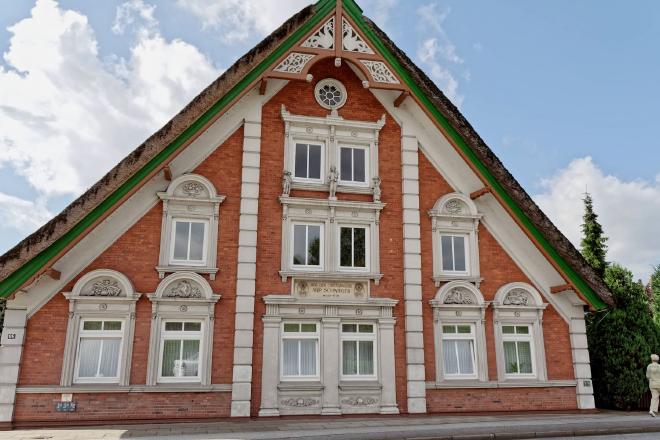On the farm

After the weekend, we go to stay with Käthe and Herbert for a few days. They live in an old farmhouse in the Altes Land, south of the Elbe. It’s a fruit farm, growing apples, pears, plums, and probably a few other kinds of fruit in small quantities. Like many small European farms it’s 100% organic, with three modern windmills providing some of its electrical power needs.
Herbert speaks some English, but is self-taught, and a little hard of hearing. Käthe’s English is better. Still, I can’t help thinking that if I’d known that one day I’d be spending time in a farmhouse in Germany, I’d have paid more attention in German lessons. Not that it would have helped that much — when they’re talking to each other, Herbert and Käthe speak Plat Deutsch, modern Low German. It sounds like a mix of German and Middle English.
So I find myself surrounded by German and dialects of German, and for a while it makes my brain hurt. By late afternoon my language processing regions have spent hours trying to decode the strange noises around me and are tired out.
Still, it makes for an otherwise relaxing break. We get up in the mornings and eat a German-style breakfast with brötchen and cheese. Herbert is mostly vegetarian these days, so we don’t have to explain our lack of enthusiasm for sausages. We get to pick and eat fruit straight from the tree, and for once I don’t have to worry about reacting to chemicals.
During the days we visit the nearby towns where rothko’s ancestors lived — Neuenfelde, Buxtehude, and Jork. We search churches and graveyards for their names. Back in the 18th Century, the well-to-do people of the town would pay for church pews, and in return they would have their names engraved on “their” pew. Unfortunately, things are made more complicated by the fact that so many people in the area had the same names. The graveyards are full of Quasts, and multiple Hans-Heinrich Hauschildts reveal that alliteration was very fashionable. On the plus side, many of the houses are decorated with the names of the members of the families that built them. Sometimes the architect gets a mention too.
We visit a couple of museums, one of which is the private museum of a collector of local historical artifacts. He has some of the old traditional clothing of the region. It turns out to have nothing to do with lederhosen, which are from the other end of Germany. Rather, the men wore black trousers and long black jackets, like you see in old photographs of Victorian England; colors were reserved for the womenfolk.
Käthe has been asking around, and eventually we make contact with a man who has been researching all the old houses of the area and the families who lived in them. He has information about a previously uncataloged branch of the family tree, and a copy of an old invoice from a blacksmith ancestor of rothko’s hundreds of years ago.
I’ve always found history interesting, and I find myself wishing I knew as much about my own forefathers.